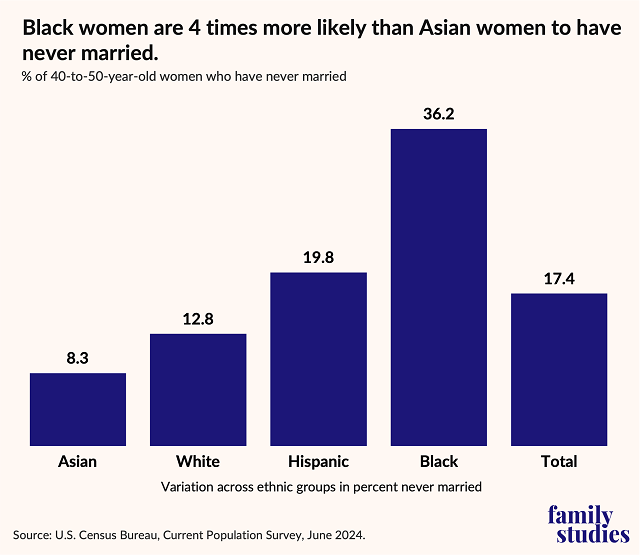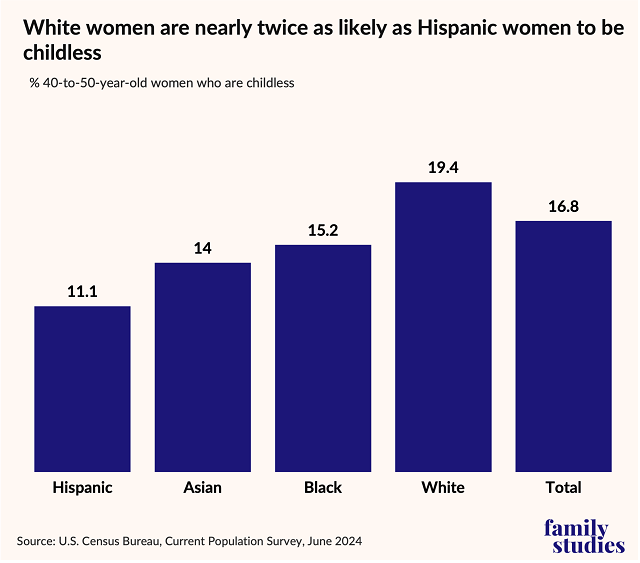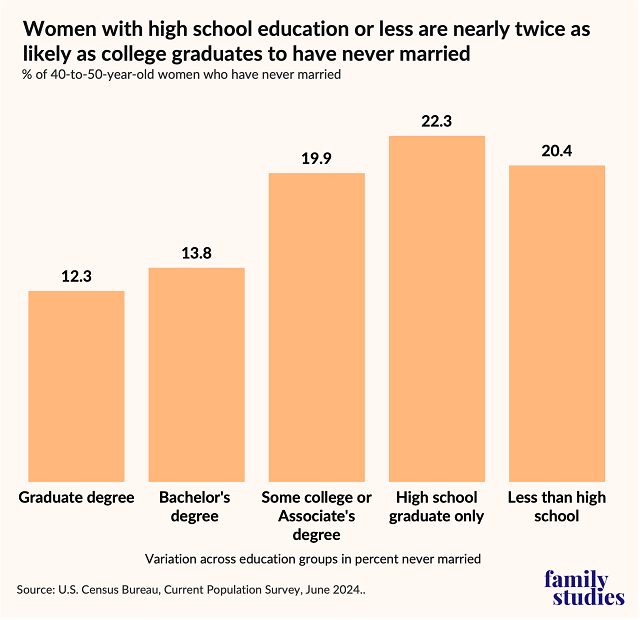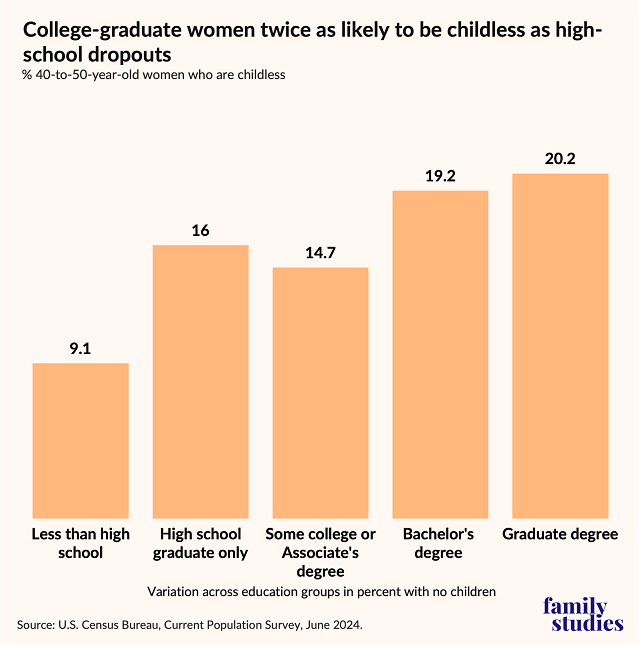Highlights
- The majority of never-married women (53%) are Black or Hispanic, whereas the majority of childless women (64%) are White. Post This
- Out of some 23 million women ages 40 to 50, 3.98 million have never married. And 3.84 million are childless. Post This
- Women in their 40s with bachelor’s or graduate degrees are twice as likely to be childless as those with less than a high school education. Post This
Are American women abandoning marriage and parenthood? Some prominent commentators fear they are. Others worry about a future like that portrayed in the 2006 movie, Idiocracy, where college-educated women and men are discouraged from reproducing. A recent report from the Census Bureau provides clues about whether these fears and worries are justified.
The Census Bureau report contains a 2024 national survey reading of how many American women have reached ages 40 to 50 without having married and having children. At first glance, the findings seem to justify concern. Out of some 23 million women in this age group, 3.98 million, or more than 1 in 6, have never married. And a similar number—3.84 million—are childless.1
Not the Same 4 Million Women
Although the proportions are similar, the makeup of the 4 million women who are still unmarried in their 40s is not the same as that of the 4 million who have never had children. In terms of race and ethnicity, the majority of never-married women (53%) are Black or Hispanic, whereas the majority of childless women (64%) are White. With respect to educational attainment, the majority of never-married women (53%) have less than a bachelor’s degree, whereas the majority of childless women (54%) have college, graduate, or professional degrees.
Black women in their 40s are four times more likely than Asian women in the same age range to have never married: 36% versus 8%. Hispanic women (20%) and White women (13%) have intermediate rates of non-marriage.

By contrast, White women are nearly twice as likely as Hispanic women to be childless in their 40s (19% vs. 11%). As the figure below shows, Black women (15%) and Asian women (14%) have intermediate rates of childlessness. Asians are the only group whose members rank relatively low in both non-marriage and childlessness. Women of other races, such as American Indian and Alaskan Natives (AIAN) and Native Hawaiian and Pacific Islanders (NHPI), as well as biracial and multiracial women, rank high in both non-marriage (23%) and childlessness (18.5%). (Not shown in figure.)

Women in their 40s with only a high-school education or less are nearly twice as likely as college graduates or those with graduate or professional degrees to remain unmarried. Their rates of remaining unmarried are 22% and 20%, versus 14% and 12%, respectively. Women with some college or associate’s degrees are similar to high-school dropouts in their rate of non-marriage (20%).

On the other hand, women in their 40s with bachelor’s or graduate degrees are twice as likely to be childless as those with less than a high school education. Their rates of being without offspring are 19% and 20% versus 9%, respectively, as shown in the figure below (4). Childlessness rates are intermediate among women who were high school graduates only (16%) or had some college or an associate’s degree (15%).

Reproduction Rates of Most Ethnic and Educational Groups Below Replacement
Twenty-three million women in the 40-to-50 age range gave birth to 45 million children, or 1.96 children per woman. This is below the so-called replacement level of slightly over 48 million children, or 2.1 per woman, that would keep the size of the U.S. population from declining (disregarding the effects of immigration).
For women in this age range, the number of children ever born per woman is below replacement level for every major racial and ethnic group except Hispanics (for whom it is just above replacement at 2.2). The numbers are lowest for White women, at 1.88 children per woman, and Asian women, at 1.72 children per women.
The average number of children ever born per woman is also below replacement for every educational attainment group, except for those who do not finish high school, for whom, at 2.58, it is above replacement. The numbers are lowest for college graduates, at 1.80, and women with graduate or professional degrees, at 1.69.
Thus, of the 23 million women ages 40 to 50 in 2024, 46% had college, graduate or professional degrees, while 54% had less than a college education. Of their 45 million children, however, only 41% were children of college graduates, while 59% were born to women with less education.
Similarly, 64% of the 23 million women were White (56%) or Asian (8%), while 36% were Hispanic, Black, or of other or multiple race/ethnicities. Of their 45 million children, however, 61% were White (54%) or Asian (7%), while 39% were Hispanic, Black, or of other or multiple race/ethnicities.
By themselves, these figures seem to lend credence to the concerns about marriage and fertility declining. But countering these worries are two developments that are working in an opposing direction. One is the growing number of women who are being awarded college, graduate, and professional degrees, coupled with a decline in the number who do not finish high school. Second, as I reported here recently, the percentage of U.S. infants born to college-graduate mothers increased significantly between 2002 and 2023, especially among Hispanic and Black women. We should certainly be working to find effective ways to encourage more young women and men to share in the joys and satisfactions of marriage and parenthood. But it does not appear that those robust institutions will be disappearing anytime soon.
Nicholas Zill is a research psychologist and a Senior Fellow of the Institute for Family Studies. He directed the National Survey of Children, a longitudinal study that produced widely cited findings on children’s life experiences and adjustment following parental divorce.
1. A related report found that between 2014 and 2024, childlessness rose among women of all age groups except 45 to 50 year olds. It rose 13% among 20 to 24 year-olds, 27% among 25 to 29 year-olds, 39% among 30 to 34 year-olds, 25% among 35 to 39 year-olds, and 23% among 40 to 44 year-olds. It fell by 11% among 45 to 50 year-olds. See: Anita Li, "Childlessness On The Rise—Except For Women Ages 45 to 50," U.S. Census Bureau, 2025.














